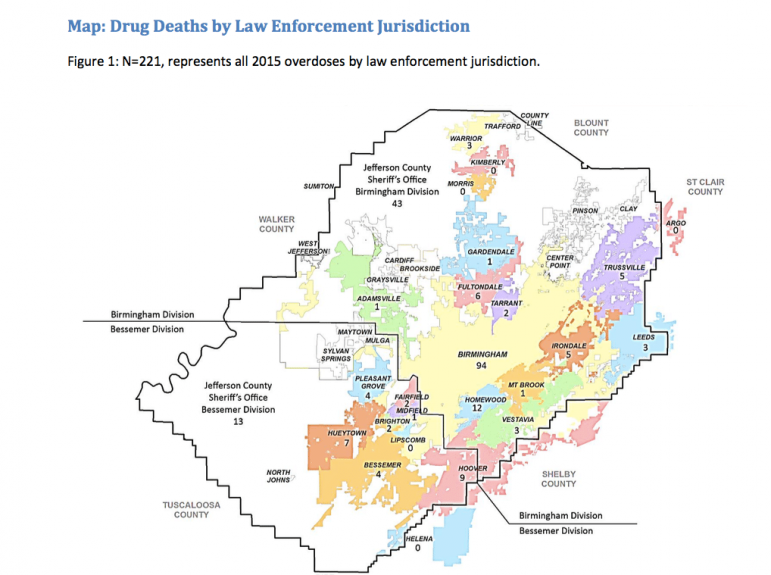In 2015, Prescription Opioid Overdoses Increased by 131 Percent
In 2015, seventy four people in Jefferson county died from prescription opioid overdoses, compared to 32 in 2014. The main culprit is fentanyl, a powerful synthetic opioid painkiller. More than half of the 74 killed by prescription opioids last year had taken fentanyl, much of which area doctors and law enforcement believe was obtained illegally.
The coroner’s report shows deaths from heroin overdose decreased by 29 percent, with 97 deaths in 2015 compared to 138 in 2014. But that might not be cause for celebration. In some cases, heroin and fentanyl were both present in a person’s system.
“This may be because the decedent was using both fentanyl and heroin, or it may be that fentanyl is replacing heroin in part or in whole in a dose purchased illicitly,” the report says.
“Fentanyl is a powerful … deadly drug,” says Joyce Vance, U.S. Attorney for the Northern District of Alabama. “Dealers are now using it to cut with heroin to increase their sales.” She says fentanyl has become a major problem around Birmingham, starting in the second half of 2015.
Stefan G. Kertesz, MD of UAB’s School of Medicine, says that while fentanyl is a prescription drug, the vast majority of fentanyl involved in these deaths was probably not legally prescribed by doctors.
“When someone dies from fentanyl, most of which is being made illegally in drug dealer labs and sold on the street, the public reports call that a ‘prescription opioid death’, even though there were no prescriptions and no doctors involved at all,” says Kertesz. “Of course, doctors do prescribe some fentanyl, but very little. All opioid prescribing is going down quickly.”
Besides fentanyl, there was a decrease in deaths caused by all other prescription opioid drugs.
Overall, deaths from illegal drugs like cocaine and methamphetamine were down last year by 30 percent in Jefferson County. In 2014, 191 people died of illegal drug overdoses, compared to 133 overdose deaths last year.
The largest decrease was in deaths due to methamphetamine, which were down 70 percent. Five people died of methamphetamine overdose in 2015, while the coroner reports 17 the previous year.
Another notable trend was a 50 percent rise in a alcohol deaths. Last year, 27 peoples’ primary cause of death was alcohol, compared to 17 in 2014.
The coroner’s office reports white males in their 30s were most likely to die from drug overdoses “across all categories with the exception of prescription medication and ethanol (alcohol).” In those instances, white males in their 50’s were most susceptible.
You can review the entire Jefferson County Coroner/Medical Examiner’s Office 2015 Annual Drug Report below.
JCCMEO 2015 Annual Drug Report by WBHM News
Photo by Jonathan Silverberg 
Alabama coal mine keeps digging after hundreds of fines and a fatal explosion
Following the death of a grandfather, Crimson Oak Grove Resources has left a community afraid for their homes and lives. An expert warns one resident may need to evacuate her home while she still can.
Florida’s 6-week abortion ban will have a ‘snowball effect’ on residents across the South
Abortion rights advocates say the ban will likely force many to travel farther for abortion care and endure pregnancy and childbirth against their will.
Attitudes among Alabama lawmakers softening on Medicaid expansion
Alabama is one of ten states which has not expanded Medicaid. Republican leaders have pushed back against the idea for years.
Birmingham is 3rd worst in the Southeast for ozone pollution, new report says
The American Lung Association's "State of the Air" report shows some metro areas in the Gulf States continue to have poor air quality.
Why haven’t Kansas and Alabama — among other holdouts — expanded access to Medicaid?
Only 10 states have not joined the federal program that expands Medicaid to people who are still in the "coverage gap" for health care
Once praised, settlement to help sickened BP oil spill workers leaves most with nearly nothing
Thousands of ordinary people who helped clean up after the 2010 BP oil spill in the Gulf of Mexico say they got sick. A court settlement was supposed to help compensate them, but it hasn’t turned out as expected.








